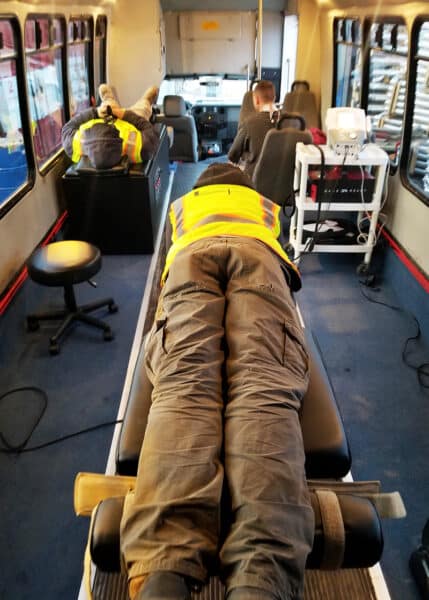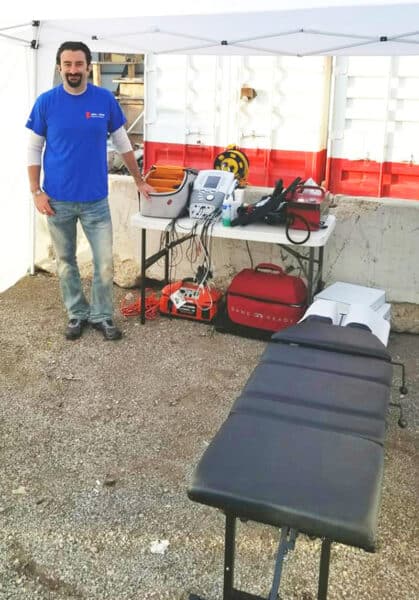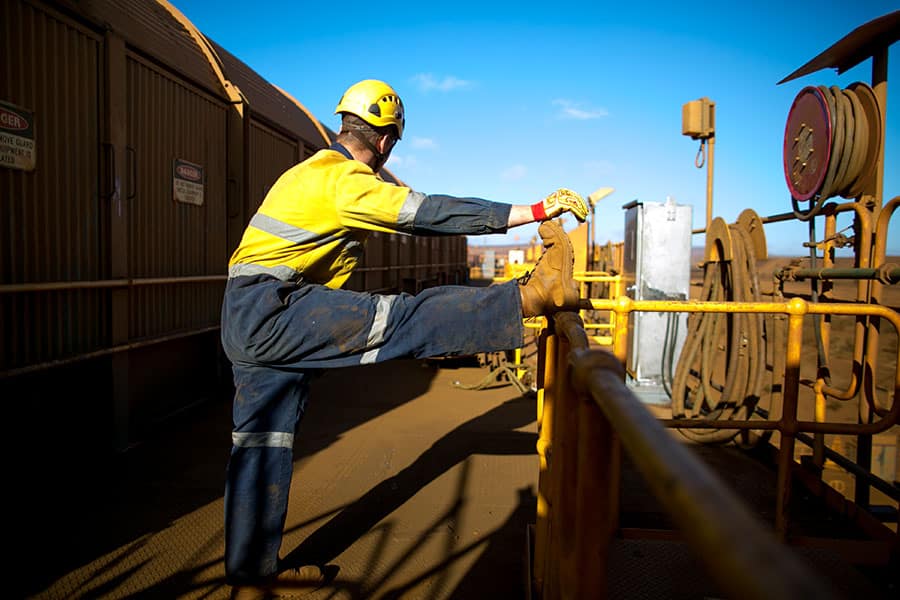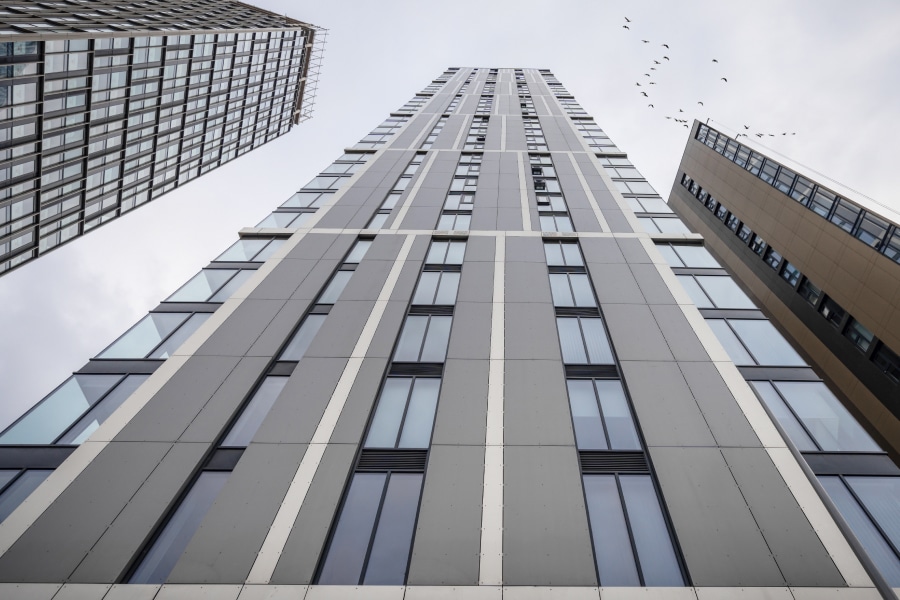Dr. Sargon Benjamin Odisho, known among his clients as “Dr. O,” thrived under the high-pressure, high-visibility work required of sports team doctors. There were moments when, standing in front of 7,000 screaming fans, he’d be on the field, deciding whether a player could get back in the game or needed to take a helicopter to the nearest hospital.
“The first couple of teams I picked up, it just felt like that was where I was supposed to be,” Odisho said. “I loved nothing more than being on the sidelines during a game and in the heat of battle.”
Today, Odisho, a chiropractic physician, is on a different field—the construction field. And he considers himself a team physician to construction crews out on jobsites.
As owner of The Chicago FIX, Odisho works with several construction companies across Chicago, providing a mobile clinic that travels to jobsites and provides guidance on stretch-and-flex programs with certified trainers, health education and dedicated clinic hours.
In many ways, construction workers’ needs are no different than athletes, Odisho said. Construction workers often face soft tissue injuries, back and shoulder pain and torn-up knees. And just like athletes, regular contact with a health care provider can get them back on the field—or job—more quickly. The biggest difference might be the luxury of time.
“With my athletes, I had a week in order to fix them before I had to get them back out into the field” for the next game, Odisho said. “With construction workers, I got until tomorrow morning.”
Pivoting to construction
Sports was natural for Odisho to gravitate toward after becoming a chiropractic physician. He was an athlete growing up and excelled in running, just like his father and son. He started serving as the team physician for the Assyrian FC Men’s Soccer Travel Team and then began working with sports teams for the Chicago police and fire departments, a minor league baseball team and world champion Irish dancers, among others.

The transition to construction began on the treatment table about five years ago. Odisho was treating the safety manager for a construction company, who was thrilled with noticeable improvement after just a couple of visits.
“He really liked our approach of how to be able to control an acute injury and get it to the point where we can both manage it together and then return him to activity faster, which is just what the construction company needed,” Odisho said. The worker asked Odisho if he might be up for working with construction workers. Odisho agreed.
Odisho began setting up on one of the company’s construction jobsites, bringing chiropractic equipment designed to provide pain relief and using giant spools—usually wrapped with conduit or wiring—as a table. Soon, Odisho invested in a tent and, eventually, a used 40-passenger shuttle bus, replacing the seats with medical equipment and turning it into a mobile clinic.
Odisho’s services were well received from the start, and eventually other construction companies brought him on. “From an employee’s stand of view, it’s nice to see that their company is going a little bit above and beyond what other companies do,” Odisho said. “I mean, nobody else brings a team physician out once a week.”
Education first
Odisho’s approach is to provide regular treatment to workers through visits with the mobile clinic, guidance on stretch-and-flex programs or at his own clinic. Odisho also serves as support after jobsite injuries, helping to assess the severity and guiding workers to needed health care services, such as an MRI.
“I help them navigate the process much more efficiently than they would have done without me, where the patient is just off on their own and they don’t know where to go,” Odisho said.
Yet, Odisho sees his role as not just providing treatment to workers, but education as well. Odisho’s sermon to construction workers is this: Every piece of equipment on the yard has a maintenance program, except one thing—them. And they deserve one, too.
“I think that drives home anything else that I can throw at them,” Odisho said. “They take more time out of their day, worrying about a piece of equipment or warming up a piece of equipment than they do themselves. And that’s not right because nothing works without them. The whole thing falls apart without them.”
RELATED:
On jobsites, Odisho sees a lot of the same problems.
Many workers start the day stiff from commutes of an hour or more. But instead of stretching to prevent injury, workers automatically move into heavy labor, stiff and prone to injuries, he said.
Small jobsite injuries can also linger—a recipe for chronic issues. For example, shoulder pain can prompt workers to hunch their neck to protect the shoulder, triggering neck issues.

“Most of the time, it’s not the initial injury,” Odisho said. “It’s the compensatory issues that they develop over a long period of time, dealing with small soft tissue issues that end up being the more devastating issues later on.”
And, with busy working schedules, construction workers often don’t make the time to see a doctor or get the equipment they need to work safely. Odisho’s guidance includes tips for what they can do at home to protect themselves—from evening stretches to the best sleeping positions to which orthotics their health insurance covers and how it can help their lower back pain.
“The education is important just because of what we’re dealing with,” Odisho said. “We don’t have much time, and they got a full week, and every day is just as hard as the last.”
Odisho knows the services he’s providing are making a difference because he sees workers under his care come back from potentially career-ending injuries. But there’s a monetary benefit, too.
Insurance company Assurance’s evaluation of Odisho’s services found that they had saved one construction company $142,000 in annual costs. With the report in hand, Odisho started marketing his services to not just safety managers, but construction company chief financial officers. “There’s a monetary value to it,” he said.
Odisho loves the pivot his business has taken. Not only is he serving jobsites in the Chicago area, but he’s also started traveling for speaking engagements with other companies. “Joke’s on them because I’m getting the biggest kick out of it,” he said.
As the pace of construction continues to grow amid historic labor shortages, making sure workers are healthy and on the job is all the more important.
“That’s not slowing down. Life’s not slowing down,” Odisho said. “We got to catch up to it. If I can do that by putting a healthier employee out there, then have at it.”












